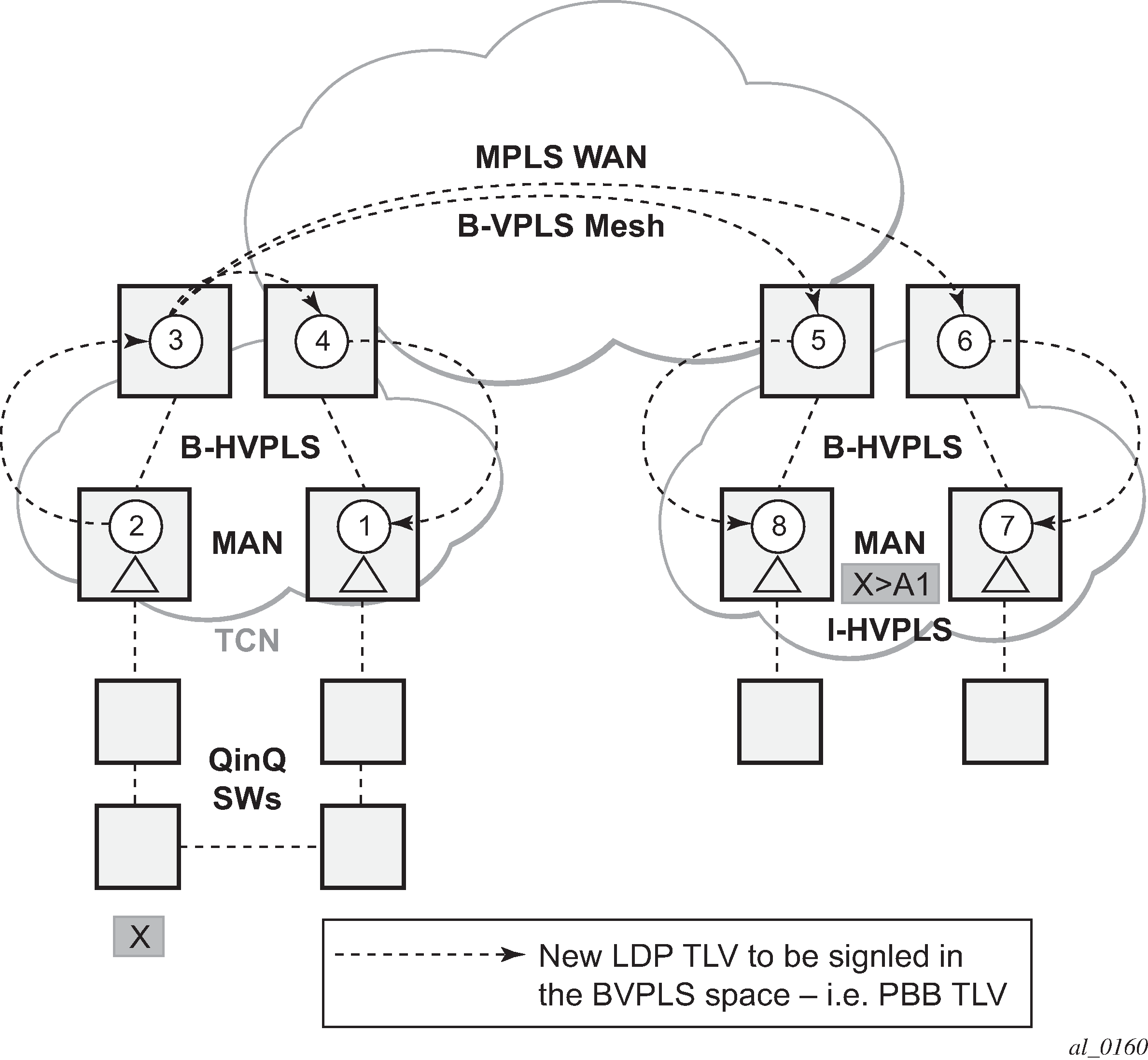In the case of an MPLS core, B-VPLS uses T-LDP signaling to set up the pseudowire forwarding. The following I-VPLS events must be propagated across the core B-VPLS using LDP MAC flush-all-but-mine or flush-all-from-me indications:
For flush-all-but-mine indication (‟positive flush”):
TCN event in one or more of the I-VPLS or in the related M-VPLS for the MSTP use case.
Pseudowire/SDP binding activation with active/standby pseudowire (standby, active or down, up)
Reception of an LDP MAC withdraw ‟flush-all-but-mine” in the related I-VPLS
For flush-all-from-me indication (‟negative flush”):
MC-LAG failure does not require send-flush-on-failure to be enabled in I-VPLS.
Failure of a local SAP requires send-flush-on-failure to be enabled in I-VPLS.
Failure of a local pseudowires/SDP binding requires send-flush-on-failure to be enabled in I-VPLS.
Reception of an LDP MAC withdraw flush-all-from-me in the related I-VPLS.
To propagate the MAC flush indications triggered by the above events, the PE that originates the LDP MAC withdraw message must be identified. In regular VPLS ‟mine”/”me” is represented by the pseudowire associated with the FEC and the T-LDP session on which the LDP MAC withdraw was received. In PBB, this is achieved using the B-VPLS over which the signaling was propagated and the B-MAC address of the originator PE.
Nokia PBB-VPLS solution addresses this requirement by inserting in the BVPLS LDP MAC withdraw message a new PBB-TLV (type-length-value) element. The new PBB TLV contains the source B-MAC identifying the originator (‟mine”/”me”) of the flush indication and the ISID list identifying the I-VPLS instances affected by the flush indication.
There are a number of advantages to this approach. Firstly, the PBB-TLV presence indicates this is a PBB MAC flush. As a result, all PEs containing only the B-VPLS instance automatically propagate the LDP MAC withdraw in the B-VPLS context respecting the split-horizon and active link topology. There is no flushing of the B-VPLS FDBs throughout the core PEs. Subsequently, the receiving PBB VPLS PEs uses the B-MAC and ISID list information to identify the specific I-VPLS FDBs and the C-MAC entries pointing to the source B-MAC included in the PBB TLV.
An example of processing steps involved in PBB MAC Flush is depicted in Figure: TCN triggered PBB flush-all-but-mine procedure for the case when a Topology Change Notification (TCN) is received on PBB PE 2 from a QinQ access in the I-VPLS domain.

The received TCN may be related to one or more I-VPLS domains. This generates a MAC flush in the local I-VPLS instances and if configured, it originates a PBB MAC flush-all-but-mine throughout the related B-VPLS contexts represented by the white circles 1 to 8 in our example.
A PBB-TLV is added by PE2 to the regular LDP MAC flush-all-but-mine. B-MAC2, the source B-MAC associated with B-VPLS on PE2 is carried inside the PBB TLV to indicate who ‟mine” is. The ISID list identifying the I-VPLS affected by the TCN is also included if the number of affected I-VPLS is 100 or less. No ISID list is included in the PBB-TLV if more than 100 ISIDs are affected. If no ISID list is included, then the receiving PBB PE flushes all the local I-VPLS instances associated with the B-VPLS context identified by the FEC TLV in the LDP MAC withdraw message. This is done to speed up delivery and processing of the message.
Recognizing the PBB MAC flush, the B-VPLS only PEs 3, 4, 5 and 6 refrain from flushing their B-VPLS FDB tables and propagate the MAC flush message regardless of their ‟propagate-mac-flush” setting.
When LDP MAC withdraw reaches the terminating PBB PEs 1 and 7, the PBB-TLV information is used to flush from the I-VPLS FDBs all C-MAC entries except those associated with the originating B-MAC BM2. If specific I-VPLS ISIDs are indicated in the PBB TLV, then the PBB PEs flush only the C-MAC entries from the specified I-VPLS except those mapped to the originating B-MAC. Flush-all-but-mine indication is not propagated further in the I-VPLS context to avoid information loops.
The other events that trigger Flush-all-but-mine propagation in the B-VPLS (pseudowire/SDP binding activation, Reception of an LDP MAC Withdraw) are handled similarly. The generation of PBB MAC flush-all-but-mine in the B-VPLS must be activated explicitly on a per I-VPLS basis with the send-bvpls-flush all-but-mine command. The generation of PBB MAC flush-all-from-me in the B-VPLS must be activated explicitly on a per I-VPLS basis with the send-bvpls-flush all-from-me command.